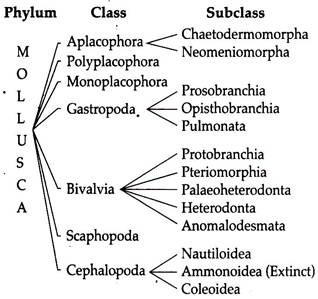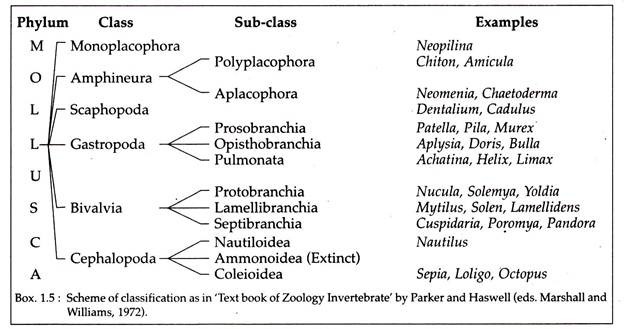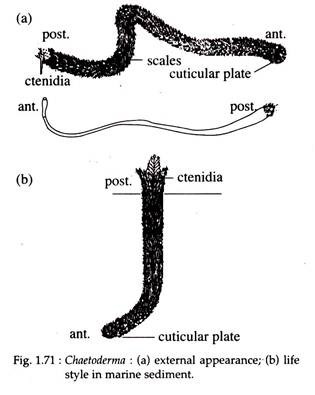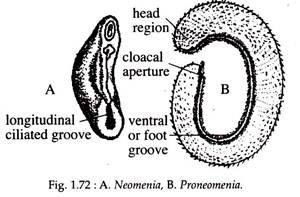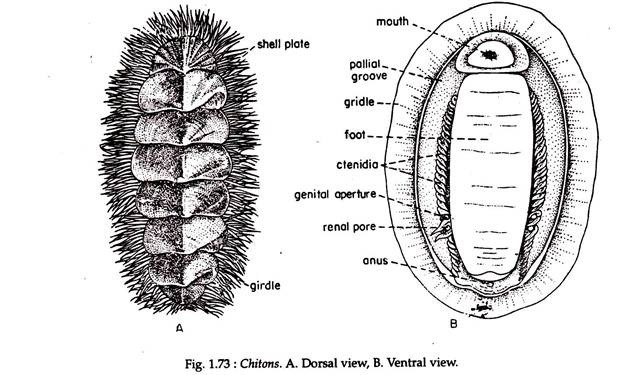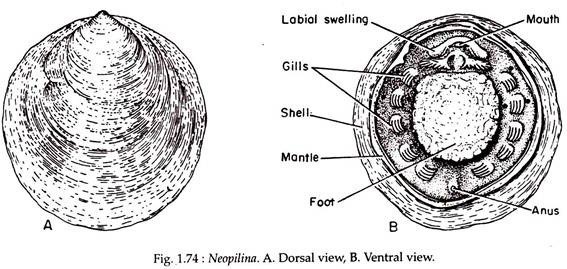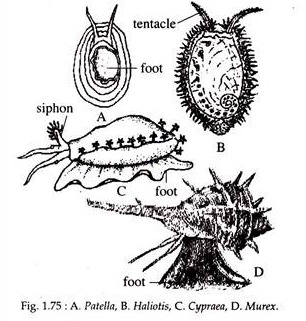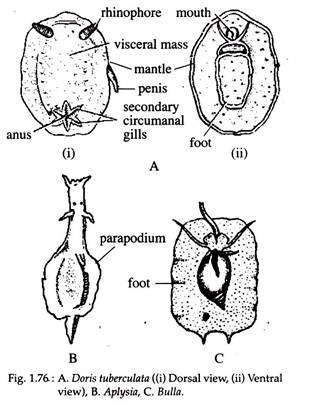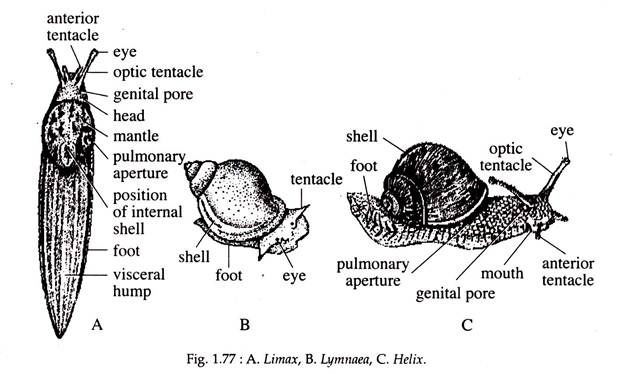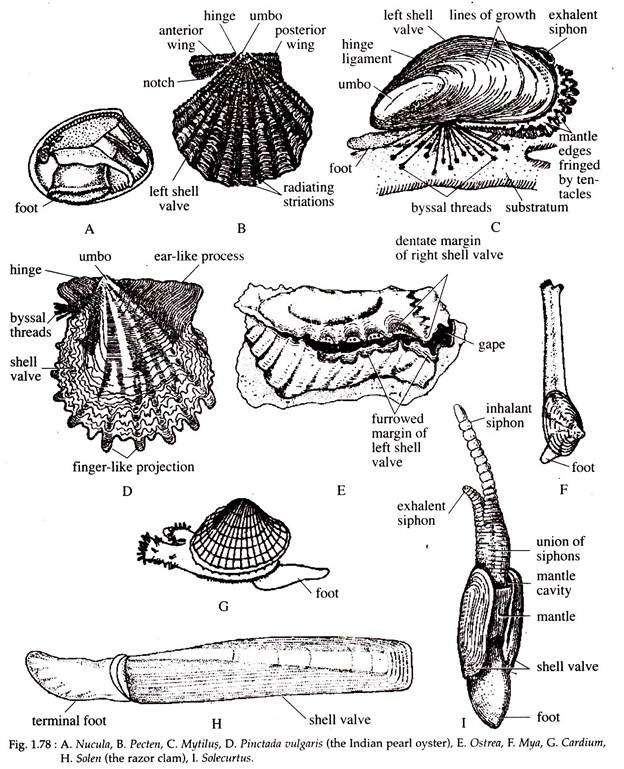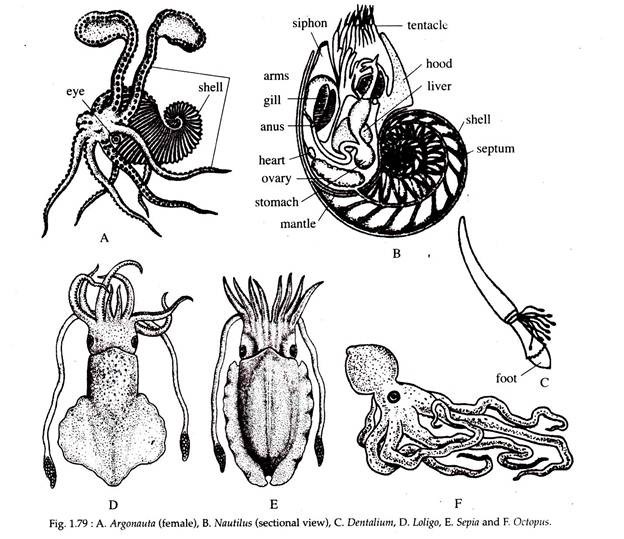In this article we will discuss about the Phylum Mollusca:- 1. Classification of Phylum Mollusca 2. Diagnostic Features of Phylum Mollusca 3. Classification 4. Systematic Resume.
Classification of Phylum Mollusca:
Phylum Mollusca is one of the most conspicuous invertebrate animals. The group Mollusca, established by Cuvier (1798), comprises of almost 1,00,000 species and is the second largest animal phylum (Fig. 1.100).
Its size ranges from minute planktonic and interstitial species to 20 m long giant squid, and includes both animals without eyes or brain and those with highly developed eyes and brain (among invertebrates). They occupy virtually every habitat available to animals, except the air. From a grazing base, molluscs have radiated to deposit feeders, suspension feeders (using gills as filters), carnivores and a few are parasites.
Etymology:
ADVERTISEMENTS:
Latin: molluscus, a soft nut or soft fungus.
Diagnostic Features of Phylum Mollusca:
1. Bilaterally symmetrical.
2. Majority are aquatic animals with a few being terrestrial.
3. Body soft, unsegmented, without a body ‘ cavity other than that provided by blood sinuses.
ADVERTISEMENTS:
4. Body monomeric and highly variable, essentially with an anterior head bearing eyes and sensory tentacles, a large flat ventral foot and a posterior mantle cavity.
5. Presence of a protective external dorsal shell. In some cases, it may be internal and covered by tissue or secondarily reduced or lost.
6. The visceral mass remains enclosed by a thick muscular fold of the body wall .called mantle.
7. A toothed, chitinous, tongue-like ribbon, the radula is present which assists in feeding.
ADVERTISEMENTS:
8. The respiratory organs are in the form of one or more ctenidia gills housed in the mantle cavity and pulmonary sacs.
9. An open blood system with a heart enclosed by the pericardium is present, through which the intestine also passes.
10. Excretory organs include a pair of saclike ‘kidneys’, opening proximally into the pericardium and discharging into the mantle cavity.
11. Nervous system comprises of a circumoesophageal ring and two pairs of ganglionated longitudinal cords with various modifications.
12. Sexes are usually separate, a few forms are hermaphrodite.
13. Typically with a single pair of gonads, discharging the gametes into the mantle cavity.
14. Cleavage is spiral.
15. Development indirect via trochophore and veliger larval stages or secondarily direct.
Classification of Phylum Mollusca:
Phylum Mollusca has been classified differently by different authors depending upon the characters of foot, mantle, shell, muscles, radula, nervous system and respiratory organs. Ruppert and Barnes (1994), Meglitsch and Schram (1991) divided Molusca into 7 classes, while Parker and Haswell (1972), Morton and Yonge (1964) have clubbed class Aplacophora and Poly- placophora into a single class Amphineura.
ADVERTISEMENTS:
Barnes et al. (1999) has split Aplacophora into two classes Chaetodermorpha and Neomeniomorpha. The classification followed here is after Ruppert and Barnes, 1994.
Systematic Resume of Phylum Mollusca:
Class Aplacophora:
1. Worm like mollusc, body covered by cuticle. Absence of shell.
2. Foot absent or reduced to a ventral ridge.
3. Mantle thick, with minute calcareous spicules.
4. Head poorly marked and without eyes or sensory tentacles.
5. There are no excretory organs.
Subclass Chaetodermomorpha:
1. The mantle covers the entire body.
2. In the posterior mantle cavity a pair of bipectinate gills are located.
3. Absence of foot.
Example:
Chaetoderma (Fig. 1.71).
Subclass Neomeniomorpha:
1. Mantle coyers the body except the ventral ridge.
2. Gills absent, but secondary gills in the form of folds or papillae are often developed.
3. Foot reduced to a ventral ridge.
Examples:
Neomenia (Fig. 1.72A), Proneomenia (Fig.1.72B).
Class Polyplacophora:
1. Body oval to somewhat elongated and dorsoventrally flattened.
2. Dorsal surface covered by eight shell plates. The surrounding mantle forms a thick ‘girdle’, the cuticle.
3. A broad muscular creeping foot is present on the ventral surface.
4. Between the foot and mantle cavity, in the pallial groove lies a number of gills.
5. Head is poorly developed. Eyes and tentacles are absent.
6. Radula is large and bears many teeth.
Example:
Chiton (Fig. 1.73), Loricata, Lepidopleurus, Chaetopleura.
Class Monoplacophora:
1. Body bilaterally symmetrical and covered by a shield-like shell.
2. On the ventral side, is a weakly muscular, circular foot surrounded laterally and posteriorly by an extensive mantle cavity.
3. On the sides of the foot are present five to six pairs of monopectinate ctenidia.
4. Head distinct but poorly developed and without sensory tentacles and eyes.
5. On the posterio-median end of the foot, anus is present.
6. Radula well developed;
Example:
Neopilina (Fig. 1.74), Mono- placophorus, Vema.
Class Gastropoda:
Greek: gastros, stomach; podos, foot
1. A muscular foot is present below the digestive system and visceral mass.
2. Visceral mass is twisted at 180° in an anticlockwise direction (torsion), relative to the head and foot.
3. Mantle cavity occupies a forwardly facing position, with the anus and kidneys discharging anteriorly.
4. Shell is in one piece and asymmetrically spiralled.
5. Head distinct with one or two pairs of tentacles and eyes. In the digestive system, buccal mass contains a scraping radula.
6. A well-developed flat, crawling foot present.
7. The mantle cavity contains a single pair of bipectinate ctenidia.
8. A chemo-receptive sense organ in the mantle cavity called the osphradium is present.
Subclass Prosobranchia:
1. Mantle cavity and contained organs are located anteriorly.
2. Presence of one or two gills within the mantle cavity anterior to the heart.
3. Shell and usually an operculum covering the shell mouth are present.
4. Nervous system forming a figure of ‘8’ due to torsion.
Example:
Patella (Fig. 1.75A), Haliotis (Fig. 1.75B), Pila (Fig. 1.81), Murex (Fig. 1.75D), Cypraea (Fig. 1.75C).
Subclass Opisthobranchia:
1. Presence of one gill, one auricle and one nephridium.
2. Various degrees of detorsion displayed with viscera and nervous system secondarily unwounded.
3. Reduction and loss of shell and mantle cavity.
4. Head bears two pair of tentacles.
5. A pair of jaw are present in the buccal cavity.
6. All are hermaphroditic.
Examples:
Aplysia (Fig. 1.76B), Doris (Fig. 1.76A), Elysia, Clio, Bulla (Fig. 1.76C).
Subclass Pulmonata:
1. One auricle and nephridium.
2. Gills absent.
3. Mantle cavity on the right side is converted into an air-breathing lung with a contractile opening, the pneumostome.
4. Shell usually present but operculum lacking.
5. Nervous system concentrated and symmetrical.
6. Hermaphroditic.
Example:
Achatina, Helix (Fig. 1.77C), Umax (Fig. 1.77A), Lymnaea (Fig. 1.77B), Ancylus.
Class Bivalvia:
1. Laterally compressed body enclosed within a pair of shell valves.
2. Relatively sedentary or even sessile.
3. Head indistinct and a radula is absent.
4. Foot blade-like in burrowing species and reduced in attached forms.
5. Mouth provided with two pairs of labial plaps.
Subclass Protobranchia:
1. Presence of bipectinate gills.
2. Possess a pair of palpal tentacles (Fig. 1.78 A).
Examples:
Nucula, Yoldia, Solemya
Subclass Pteriomorphia:
1. Attached by byssus threads or cemented to the substratum, some secondarily free.
2. Mantle margins not fused.
Examples:
Mytilus (Fig. 1.78C), Pinctada (Fig. 1.78D), Ostrea (Fig. 1.78E), Lima, Pecten (Fig. 1.78B).
Subclass Palaeoheterodonta:
1. Valves equal with a few hinge teeth. Valves may be round to elongated or triangular.
2. Presence of inner nacreous layer in the shell.
3. Usually without siphons.
Examples:
Anodonta, Trigonia, Mutela, Elliptio, Lamellidens.
Subclass Heterodonta:
1. Valves equal with a few large cardinal teeth separated from the elongated lateral teeth, by a toothless space.
2. Shell without nacreous layer.
3. Usually siphons are present.
4. Gills eulamellibranch.
Examples:
Solen (Fig. 1.78H), My a (Fig. 1.78F), Cardium (Fig. 1.78G), Solecurtus (Fig. 1.781).
Subclass Anomalodesmata:
1. Valves equal with no hinge teeth.
2. Mantle margin fused and siphonated.
3. Adductor muscles more or less equally developed.
Examples:
Pandora, Poromya, Cuspidaria, Lyonsia.
Class Scaphopoda:
Greek: skaphe, boat; podos, foot.
1. Presence of a tubular, tusk-like shell, open at both ends.
2. The elongated body completely enclosed by the mantle.
3. From the large ventral opening of the shell projects the conical or cylindrical burrowing foot and buccal region.
4. Buccal mass possess a radula.
5. The small proboscis-like head lacks eyes and sensory tentacles.
6. Paired clusters of narrow, clubbed adhesive, contractile filaments, the captacula surrounding the mouth and are used in feeding.
7. Gills absent, instead a part of mantle serves for gaseous exchange.
8. Circulatory water enters and leaves through the small posterior opening.
9. Possess a single gonad that discharges via the right kidney.
Examples:
Dentalium (Fig. 1.79C), Cadulus.
Class Cephalopoda:
Greek: Kephale, head; podos, foot.
1. Foot modified into a series of prehensile arms or tentacles and siphon.
2. Shell absent or reduced and covered by the mantle in most species.
3. This group has a well formed head bearing large eyes.
4. Mouth possesses radula and jaws.
5. Presence of a single gonad and development is direct.
Subclass Nautiloidea:
1. Presence of external shell.
2. Four ctenidia, four auricles and four kidneys are present.
3. Possess many slender, suckerless tentacles.
Example:
Nautilus (Fig. 1.79B).
Subclass Coleoidea:
1. Shells internal, reduced or absent.
2. Presence of two ctenidia, two auricles and two kidneys.
3. The eight or ten arms bear suckers.
Examples:
Sepia (Fig. 1.79E), Loligo (Fig. 1.79D), Octopus (Fig. 1.79F), Argonauta (Fig. 1.79 A).
